The Microsoft Surface Laptop 3 Showdown: AMD's Ryzen Picasso vs. Intel's Ice Lake
by Brett Howse & Andrei Frumusanu on December 13, 2019 8:30 AM ESTGPU Performance - Vega vs Iris
After many tests, it is very clear that Intel’s Ice Lake platform offers a significantly faster CPU, and the results were unsurprising. Although the Ryzen Mobile 3000 platform did launch in 2019, it already struggled on CPU tests against the older Skylake core processors. But on the GPU side, Intel is the one that needs to play catch-up. Previous to Ice Lake, Intel’s standard GT2 GPU platform, found on almost all U-Series 15-Watt processors, offered 24 execution units of their Gen 9.5 GPU. AMD squeezed their Vega GPU architecture into their Ryzen SoC, which could easily double the performance of the Gen 9.5 GT2 GPU.
Ice Lake is Intel’s first real attempt to make a powerful iGPU a standard feature for their CPUs, although it is only a first step. But the new Gen 11 architecture brings some improvements such as more advanced tile-based rendering, variable rate shading, and of course the LPDDR4X-3733 memory adding significant bandwidth, greatly helping the GPU. The biggest change though is just how much die space Intel has dedicated to graphics, jumping from 24 EUs on a full GT2 to 64 EUs on a full GT2 part such as the Core i7-1065G7. And, following in AMD’s footsteps again, Intel is offering cut-down GPUs on lower-spec processors. It’s confused their already confusing processor naming, but the lowest-spec Core announced so far still has 32 EUs, meaning it is still better than the previous gen even at the “G1” level.
AMD has some tricks up their sleeves as well. For the Surface Laptop 3, Microsoft requested a slightly more powerful configuration for their Surface-branded processor. While the CPU side matches the same specifications as the non-Surface CPUs, Microsoft's processor SKUs add an extra GPU Compute Unit to both its Ryzen 5 and Ryzen 7, bringing them to 9 and 11 respectively. So the Surface Laptop 3 should be the best possible showcase for GPU performance on the 3000 series Ryzen mobile APU.
Before the results, let’s go over the driver situation. The Intel system ships with an updated driver over what we used on the Dell XPS 13 2-in-1, which resolves the 3DMark issues we saw on that laptop. The driver is from 2019-11-06 and is version 26.20.100.7463. The AMD platform’s driver is from 2019-10-07 and is version 26.20.12027.5004. Unfortunately, the AMD driver can’t be updated from AMD directly, and instead will be released by Microsoft. The current driver has some quirks, so an updated driver is needed for usability, but it did not prevent any GPU workloads from being run. But, the AMD system would only output 1280x720 where we normally test at 1366x768, and attempts to output to an external monitor were thwarted by the buggy driver, so be aware that in most of the gaming tests, the AMD system was outputting at a slightly lower resolution.
Let’s see how the do starting with some synthetics, and then moving to some real-world games.
3DMark
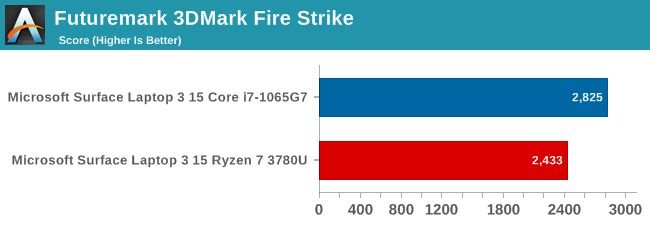
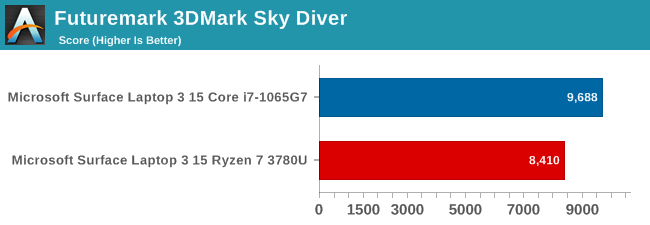
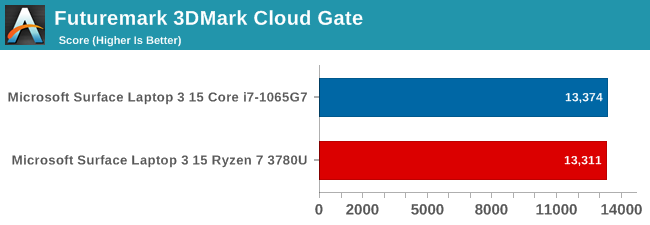
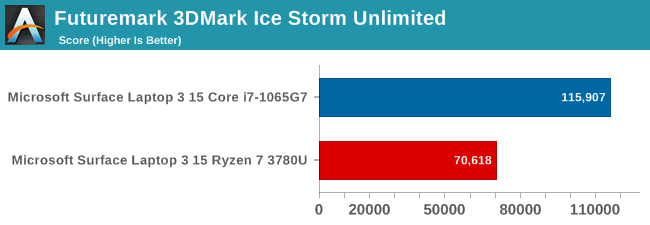
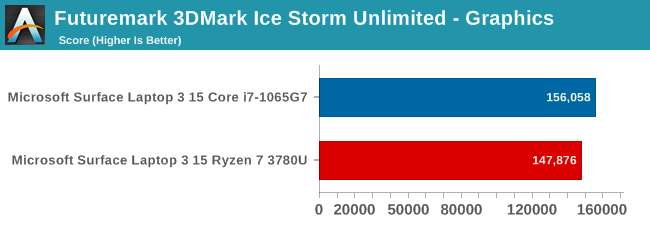
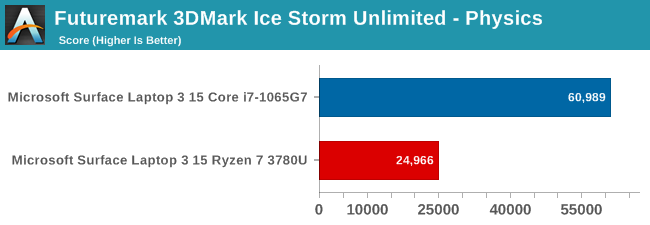
3DMark offers several tests of varying complexity, from Fire Strike as the most demanding, to Ice Storm Unlimited, which can be run on tablets. Here the Ice Lake platform pulls ahead, with better CPU performance helping quite a bit, although the Ice Lake’s Iris Plus graphics is also able to outperform Vega 11 as well.
GFXBench

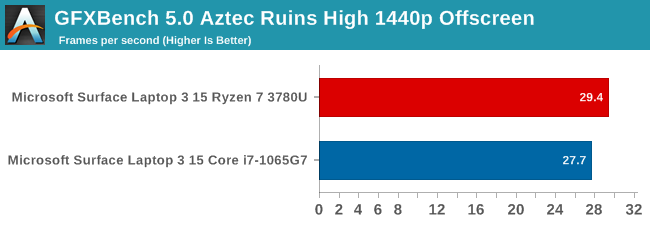
Kishonti’s latest GFXBench suite added DirectX 12 tests to the fold, making it far more relevant than the older OpenGL versions available on the desktop previously. AMD’s previous work in low-level drivers when they developed Mantle has provided the groundwork for DX12 as well, with Vega 11 offering slightly better results than Iris Plus in this test.
Tomb Raider

Running at our value settings, Tomb Raider was easily playable on both systems, with framerates approaching 100 FPS. The Ice Lake platform performed better on this test.
Rise of the Tomb Raider
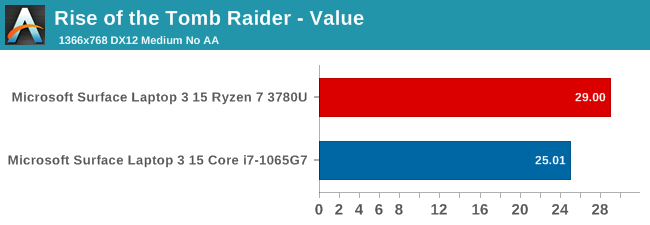
The second installment in the Tomb Raider series offers much more demanding visuals, and both systems struggle to play it at our value settings. The DirectX 12 title performs slightly better on Vega, and with some additional settings tweaks, the game would be playable, which is not something you could have said on an integrated GPU previous to Ryzen and Ice Lake.
Strange Brigade
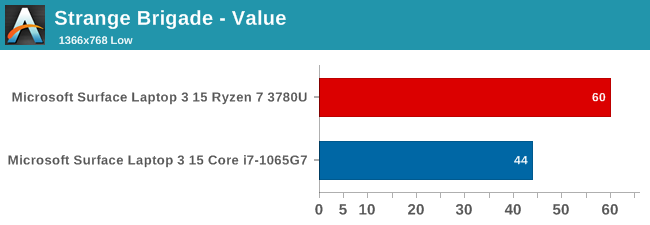
A new title we’re bringing to our laptop suite is Strange Brigade, which scales down nicely on integrated graphics. This game also supports DirectX 12, and as tends to be the pattern, performs very well on Vega 11.
F1 2017
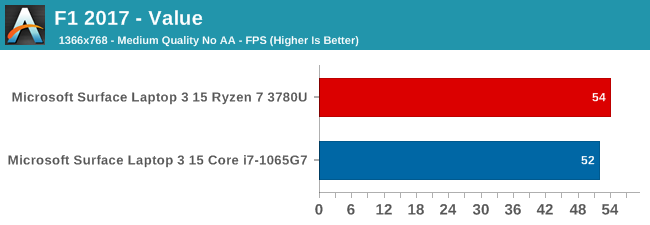
Back with a DirectX 11 title, we see that Intel has again closed the gap, and this game tends to be somewhat CPU bottlenecked as well, so the Sunny Cove cores likely help out here too, but once again Vega 11 wins, if only by a nose.
F1 2019
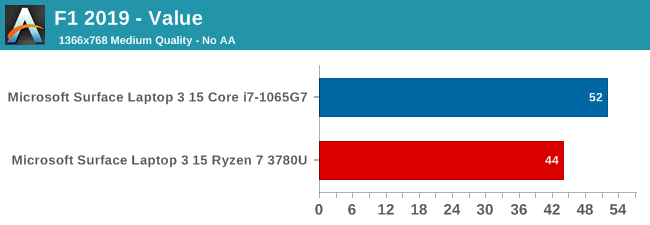
Codemasters updated the underlying EGO engine to support DirectX 12, which was utilized on this test. Despite that, the Vega 11 GPU is a bit slower than the Iris Plus in this test.
Far Cry 5
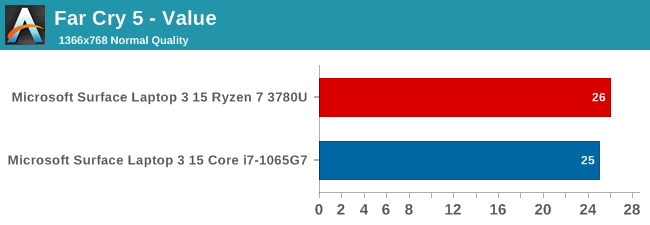
Both systems are within striking distance of being playable, which is somewhat remarkable since the Far Cry series is one of the most popular AAA first-person shooters. The Vega 11 GPU was slightly ahead, which is somewhat surprising as this game tends to be CPU bound, but clearly at this low of a GPU limit that hasn’t come into play yet.










174 Comments
View All Comments
Korguz - Friday, December 20, 2019 - link
HStewart.. and yet to STILL believe the lies intel tells you.. that is why you are thought of as an intel fanboy... until intel delivers on what they claim, and actually have products out, and no, the limited products on 10nm, that max out at quad core and lower frequencies then 14, does NOT count, anything they say, should be treated as BS...going by your post.. you have NO proof of your claims... and they are in fact, just your opinions...
MBarton - Monday, December 30, 2019 - link
At this point Intel's roadmaps are nothing more than lip service for investors. Absolutely nobody takes them seriously.djayjp - Friday, December 13, 2019 - link
AMD should've led Zen 2 (third gen Ryzen) with mobile first. Oh well maybe next generation.djayjp - Friday, December 13, 2019 - link
Also the marketing name for the chips really doesn't help, in fact I think it works against them and makes them look bad.ChubChub - Sunday, December 15, 2019 - link
Absolutely this. A friend's 6600k just died, and wanted to go with AMD. I'm up to date with most computer stuff, so he asked my opinion.He was thinking a 3400g,because APU + 3rd gen Ryzen. It was weird to tell him that AMD stupidly named the 1st gen APUs with the 2nd gen nomenclature … then continued this stupidity for no reason. All chips 1xxx are Zen, all 2xxx chips are Zen+, all 3xxx chips are ZEN 2 … well, except the APUs, which are all back a generation.
I have high hopes for the 4xxx APUs; would be nice if they fixed the naming by pushing them back to 3xxx. However, even better would be Zen 3 cores in mobile; 4xxx naming would then make sense, they could get some volume out on the 7nm+ process that already works, use ASMedia/VIAs new higher efficiency chipset slated for Zen 3, and they'd likely decidedly obliterate Intel's offerings on CPU and GPU performance (probably not on power though; Intel is doing some good stuff there). One can dream.
MikhailT - Friday, December 13, 2019 - link
I disagree, AMD is winning over a lot of the big businesses with their EPYC chips. They need the cash more than they need laptop revenue at the moment and 7nm capacity is very limited. It's best to start with the highest-profit maker first.Get the business on their side, get more money to grow their team and then they'd be able to do more stuff at the same time like Mobile, Server, Desktop, Gaming, and so on.
All this means is that we can hope to look forward to see what Surface Laptop 4 can do with AMD's Zen 2 chips when it comes out next year.
MBarton - Monday, December 30, 2019 - link
Why? So AMD can delay their most valuable products (Epyc and Threadripper) so they can attempt to make some low margin mobile sales? Ridiculous. Mobile is one area that Intel is still fairly competitive in. There's no reason to give up high margin markets where AMD has a strong advantage, for a market where AMD would be forced to compete head on with Intel 10nm for low margin sales.Fataliity - Friday, December 13, 2019 - link
It is interesting how you did the test. I understand ur playing at "Value" because its a laptop. But if its getting 100FPS why couldn't you turn up the graphics a bit to get around 60, to show what people should expect? Because at "Value" you are purposelly making the 18% IPC affect the FPS in the situation (720p is "CPU Bound" at low)...I also noticed you used alot of "real world" names for your cpu tests, even synthetics. While the gpu synthetics you just called "gpu tests"...
... You put the Ice Lake system in the best possible light is what I"m saying. Gave it every advantage. Why?
Lord of the Bored - Saturday, December 14, 2019 - link
Because it is the thirteenth. They are wildly and insanely obviously in the pocket of Intel on odd days. Come back on an even day if you want an AMD-biased test, because those are the days AMD bought.Brett Howse - Saturday, December 14, 2019 - link
Because we use the data for future articles:https://www.anandtech.com/bench/Notebook/725
If I run at random settings then the data isn't useful for the future.
Also if anything the AMD system was put in the best light because it was running at 1280x720 instead of 1366x768, as mentioned in the article.